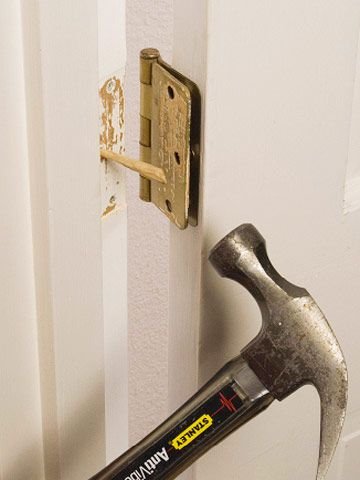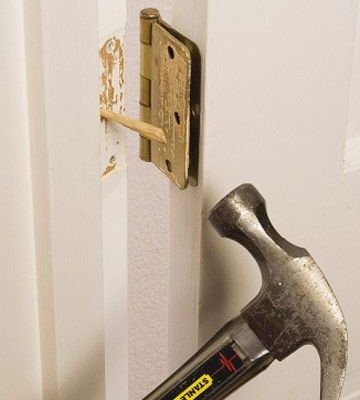
When this happens, it’s tempting to blame the door, the weather, or maybe even your own strength for yanking it open. But let me explain: most of the time, the real troublemaker is the hinge, especially on heavier exterior doors like the main entry or a solid wood patio model. Brands like Schlage, Kwikset, and Yale all use variations of the same basic hinge design, so the troubleshooting steps are usually similar no matter what’s stamped on your hardware.
Let’s dig into what actually causes a hinge to slip out of plumb, how you can spot the early warning signs, and the step-by-step fixes that really work. I’ll walk you through each part slowly, like we’re checking your door together—no jargon, just clear explanations and a little patience.
What Does “Out of Plumb” Mean for Door Hinges?
A hinge that’s “out of plumb” basically means the hinge isn’t hanging straight up and down—like a picture frame that’s tilted on the wall. On an exterior door, this gets tricky because these doors are heavy, and they have to seal out weather, pests, and even intruders. If the hinge is off-kilter, the whole door can sag, rub, or just never latch right.
You might be wondering, “So what exactly does plumb look like?” Imagine holding a laser level or a carpenter’s plumb bob alongside your door’s edge. If the hinge pin isn’t lined up dead vertical, you’re dealing with an out-of-plumb situation. It sounds fussy, but honestly, even a little lean can throw off your door’s smooth swing.
Some common signs of an out-of-plumb hinge include:
- Your door sticks or scrapes along the frame or threshold—especially near the top or bottom corner.
- The gap between the door and the frame isn’t even all the way around. One part might be tighter or looser than the rest.
- You notice the hinges look twisted, bent, or pulled away from the wood.
If you catch the problem early, the fix is usually simple. But left alone, an out-of-plumb hinge can cause serious wear, even warping the door or stripping out the screws.
Why Does an Exterior Door Hinge Go Out of Plumb?
You might be asking, “How does a hinge even end up crooked?” Here’s the thing: exterior doors take a pounding. They’re exposed to everything—rain, sun, wind, slamming, constant opening and closing—and all that stress adds up.
A few common culprits:
- Loose screws: Over time, the screws holding the hinge to the door or frame can wiggle loose, especially if the wood underneath has softened from moisture.
- Heavy or oversized doors: Some beautiful solid wood or metal doors can be so heavy that the standard hinges just can’t keep up. Eventually, gravity wins.
- Improper installation: If the hinges weren’t set perfectly straight at the start, or if there’s a gap behind one side, the whole setup might shift out of plumb.
- Worn out hinges: Hinges don’t last forever. Rust, dirt, and everyday friction can wear down the metal or cause pins to bend.
Even one loose screw or slightly warped hinge can throw off the whole door. The good news? Most of these problems are fixable with a little patience and a screwdriver.
How to Check If Your Exterior Door Hinge Is Out of Plumb
Before you start unscrewing anything, it’s smart to confirm the hinge is actually the problem. Here’s a step-by-step way to check, without any fancy tools:
- Open and close the door slowly. Watch and listen for sticking, scraping, or moments when the door seems to drag. Pay attention to the spots where it gets hung up.
- Look at the gaps. With the door closed, check the gap (reveal) between the door and frame on all sides. If the gap is wide in some spots and tight in others, something’s off.
- Examine the hinge alignment. Stand at the edge of the open door and sight down the line of the hinges. The pins should all be in a straight, vertical line. If they’re not, you’re looking at an out-of-plumb hinge.
- Check for loose or damaged screws. Gently wiggle the hinge leaf (the flat part on the door or frame). If it moves—even a little—those screws need attention.
Sometimes, the hinge itself looks fine, but the mounting screws are stripped out of the wood. In that case, you’ll need to reset or replace them for a sturdy repair.
Step-by-Step: Fixing an Out-of-Plumb Door Hinge
Here’s the part where you grab your tools and get hands-on. Don’t worry—fixing an out-of-plumb hinge is something most folks can do in an afternoon, even if you’ve never tried before. Here’s a clear, detailed process:
- Tighten all hinge screws. Use a screwdriver, not a drill, to avoid stripping the screws. Make sure every screw is snug. If the screw just spins, the hole may be stripped—jump to the next step.
- Repair stripped screw holes. Remove the loose screw. Fill the hole with a wooden golf tee, toothpicks coated in wood glue, or even a wood dowel. Let it dry, then trim flush and re-drive the screw. This gives the screw fresh wood to grab onto.
- Replace bent or worn hinges. If the hinge leaf is twisted or the pin is bent, swap it out for a matching new hinge. Most standard door hinges are easy to find at the hardware store—just bring the old one for comparison.
- Shim the hinge if needed. If the door is still sagging after those steps, you may need to shim behind the hinge to tilt it back into plumb. Use thin cardboard or plastic shims behind the leaves—add just enough to straighten the alignment.
- Check and adjust. Open and close the door between each step to watch how things improve. Once the hinges are lined up and tight, your door should swing easily and the gaps should look even.
You might be tempted to just “muscle” the door closed or ignore the drag, but honestly, taking the time to reset the hinges now can save you from repairing a warped door or frame later.
Common Complications and Alternative Fixes
Here’s the thing: not every out-of-plumb hinge fix is simple. If you’ve tightened the screws, replaced broken parts, and the door still won’t hang right, something bigger might be happening.
- Frame issues: Sometimes, it’s not the hinge at all—the door frame itself might be out of plumb, especially in older homes or places with foundation settling. In this case, you might need to call a pro for realignment or even frame repair.
- Oversized or heavy doors: If your exterior door is unusually heavy (like a vintage solid wood door), consider upgrading to ball bearing hinges or those made for heavy-duty use. They resist wear and keep alignment better over time.
- Weather-stripping interference: Occasionally, thick or misaligned weather-stripping can push the door off kilter, making it seem like a hinge problem when it’s not. Double-check the rubber seals and sweep strips before blaming the hardware.
- Universal vs. brand-specific hinges: Universal hinges fit most doors, but if you have a branded system (like Kwikset or Schlage), it’s safest to stick with their hardware for a perfect match—especially if your door has multiple locking points or unique security features.
If you’re feeling overwhelmed or worried about messing up your entry door, there’s no shame in calling a local handyman for a fresh set of eyes. Sometimes a pro can spot a warped jamb or rotted wood that’s easy to miss.
Preventing Future Out-of-Plumb Hinge Problems
Now that you’ve fixed your hinge, let’s keep it that way. Doors, especially those exposed to the elements, need a bit of ongoing TLC to stay smooth and aligned.
- Periodic hinge tightening: Every six months or so, grab a screwdriver and check all the hinge screws for snugness. Wood expands and contracts with the seasons, so even a tight screw can loosen over time.
- Keep hinges clean and lubricated: A quick squirt of silicone spray, graphite, or a tiny drop of oil on the hinge pin can keep things swinging smoothly. Wipe away excess—no one needs greasy fingerprints on their door.
- Inspect for moisture damage: Check the area around the hinge for signs of rot, swelling, or softness—especially on older doors or those without wide overhangs. Catching moisture early can prevent bigger repairs later.
- Don’t overload the door: Heavy wreaths, decorations, or even extra locks can stress your hinges. If you love a decked-out entryway, consider upgrading your hardware to handle the extra load.
A few minutes of prevention now can spare you afternoon-long repair sessions later.
Comparing DIY and Professional Solutions
You might be on the fence: should you tackle the hinge repair yourself, or just call in an expert? Here’s a quick rundown of the pros and cons for each route:
- DIY fixes: Most basic hinge problems—loose screws, stripped holes, replacing worn hardware—are totally doable with common tools. It’s cheap, quick, and pretty satisfying to see immediate results.
- Professional repair: If your frame is damaged, the door is warped, or you’ve tried all the basic steps without luck, it’s smart to call in a pro. They can spot deeper issues and have the right tools for major alignments.
- Cost comparisons: DIY costs next to nothing, especially if you already have a screwdriver and some wood glue on hand. Hiring a pro usually runs $75–$150 for a typical hinge or minor frame adjustment, but can go higher if more complex carpentry is needed.
- Warranty and safety: If your door is under warranty or part of a security system (think Yale smart locks or multi-point entries), tampering with the hinges yourself might void coverage. Double-check your manual before starting.
Bottom line: most folks can handle the basic fixes with a little patience and care. But if you get stuck or notice bigger issues, don’t hesitate to get help.
Wrapping Up: Don’t Let an Out-of-Plumb Hinge Slow You Down
Here’s what it really comes down to: a door hinge that’s out of plumb is one of those small annoyances that can turn into a major headache if ignored. But with a careful eye and a steady hand, you can tackle most hinge issues yourself, saving money and keeping your entryway secure and smooth.
Remember to check your hinges regularly, use the right repairs for your door’s size and weight, and don’t be afraid to upgrade if your hardware is showing its age. Whether you’re working with universal parts or a specific brand like Kwikset, taking the time now prevents even bigger headaches later.
A properly aligned hinge means every trip through your front door feels just right—no wrestling, no scraping, just that satisfying click of things working the way they should. So go ahead, give your door a check-up. You’ll be glad you did.
